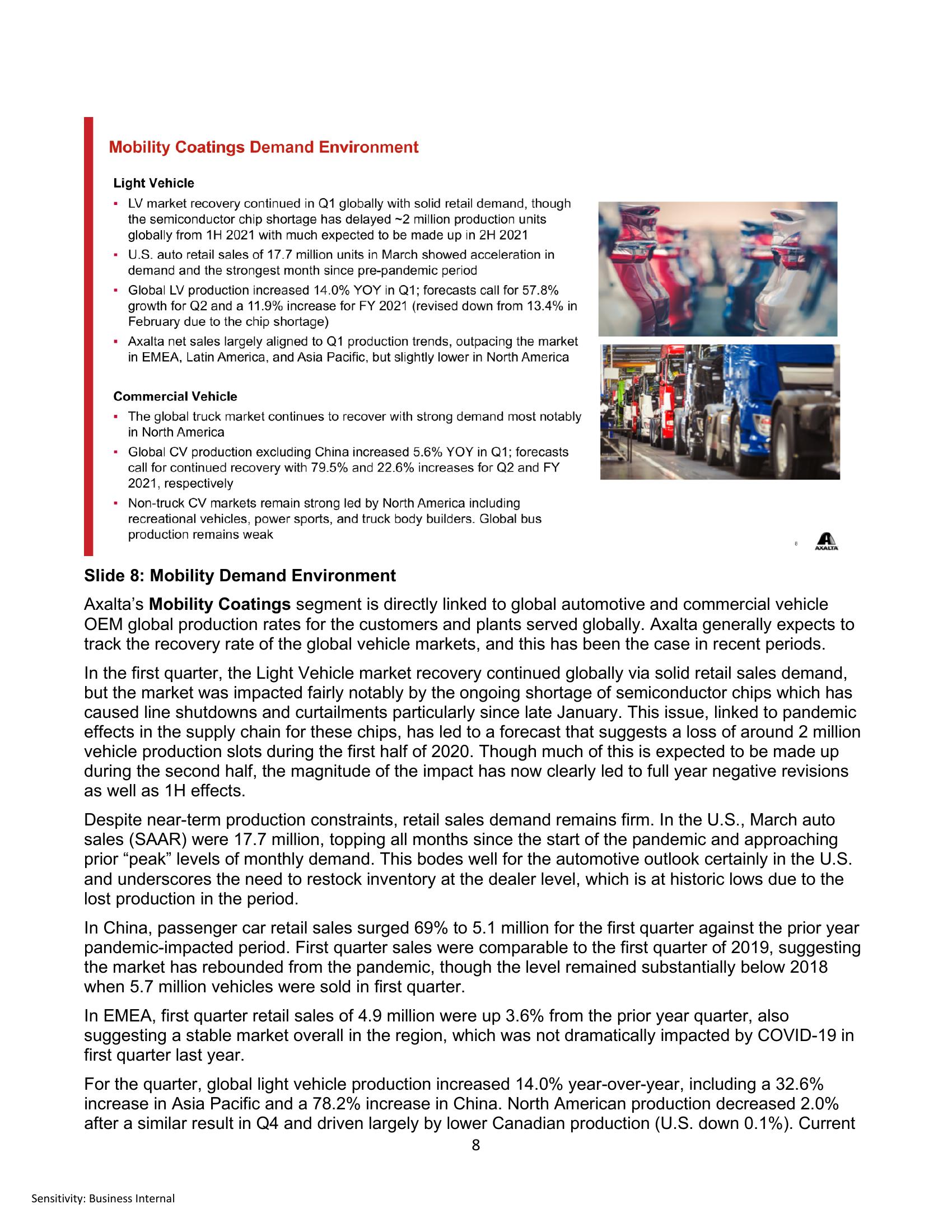Axalta Coating Systems (axta) First Quarter 2021 Financial Results
Mobility Coatings Demand Environment
Light Vehicle
LV market recovery continued in Q1 globally with solid retail demand, though
the semiconductor chip shortage has delayed ~2 million production units
globally from 1H 2021 with much expected to be made up in 2H 2021
■
"
·
■
■
"
U.S. auto retail sales of 17.7 million units in March showed acceleration in
demand and the strongest month since pre-pandemic period
Commercial Vehicle
The global truck market continues to recover with strong demand most notably
in North America
■
Global LV production increased 14.0% YOY in Q1; forecasts call for 57.8%
growth for Q2 and a 11.9% increase for FY 2021 (revised down from 13.4% in
February due to the chip shortage)
Axalta net sales largely aligned to Q1 production trends, outpacing the market
in EMEA, Latin America, and Asia Pacific, but slightly lower in North America
Global CV production excluding China increased 5.6% YOY in Q1; forecasts
call for continued recovery with 79.5% and 22.6% increases for Q2 and FY
2021, respectively
Non-truck CV markets remain strong led by North America including
recreational vehicles, power sports, and truck body builders. Global bus
production remains weak
A
AXALTA
Slide 8: Mobility Demand Environment
Axalta's Mobility Coatings segment is directly linked to global automotive and commercial vehicle
OEM global production rates for the customers and plants served globally. Axalta generally expects to
track the recovery rate of the global vehicle markets, and this has been the case in recent periods.
In the first quarter, the Light Vehicle market recovery continued globally via solid retail sales demand,
but the market was impacted fairly notably by the ongoing shortage of semiconductor chips which has
caused line shutdowns and curtailments particularly since late January. This issue, linked to pandemic
effects in the supply chain for these chips, has led to a forecast that suggests a loss of around 2 million
vehicle production slots during the first half of 2020. Though much of this is expected to be made up
during the second half, the magnitude of the impact has now clearly led to full year negative revisions
as well as 1H effects.
Despite near-term production constraints, retail sales demand remains firm. In the U.S., March auto
sales (SAAR) were 17.7 million, topping all months since the start of the pandemic and approaching
prior "peak" levels of monthly demand. This bodes well for the automotive outlook certainly in the U.S.
and underscores the need to restock inventory at the dealer level, which is at historic lows due to the
lost production in the period.
In China, passenger car retail sales surged 69% to 5.1 million for the first quarter against the prior year
pandemic-impacted period. First quarter sales were comparable to the first quarter of 2019, suggesting
the market has rebounded from the pandemic, though the level remained substantially below 2018
when 5.7 million vehicles were sold in first quarter.
In EMEA, first quarter retail sales of 4.9 million were up 3.6% from the prior year quarter, also
suggesting a stable market overall in the region, which was not dramatically impacted by COVID-19 in
first quarter last year.
For the quarter, global light vehicle production increased 14.0% year-over-year, including a 32.6%
increase in Asia Pacific and a 78.2% increase in China. North American production decreased 2.0%
after a similar result in Q4 and driven largely by lower Canadian production (U.S. down 0.1%). Current
8
Sensitivity: Business InternalView entire presentation